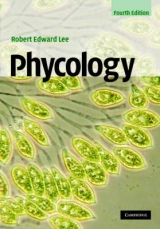
Phycology
Cambridge University Press (Verlag)
978-0-521-63090-0 (ISBN)
- Titel erscheint in neuer Auflage
- Artikel merken
Phycology is the study of algae, a ubiquitous and extremely important range of species ecologically because of the dependence of other species on their primary production. This third edition of Phycology is designed to serve both as a textbook for a one-semester course and also as a reference on modern concepts in the study of algae. Algae are divided into four natural groups and chapters on each group cover the cytology, morphology, physiology, life cycles, ecology and systematics, all presented in a manner that can be understood by readers with a basic knowledge of biology. The use of clear, concise drawings, as well as the special emphasis placed on those algae that are commonly covered in phycology courses, and encountered by students in marine and freshwater habitats, has led to the establishment of this book as a classic introductory text suitable for courses throughout the world.
Robert Edward Lee was educated at Cornell University (BS, 1960–64) and the University of Massachusetts, Amherst (Ph.D., 1966–71) and served as a Platoon leader in the US Army First Infantry Division (1964–66). He was Lecturer at the University of the Witwatersrand, Johannesburg (1971–77), Associate Professor at Shiraz (Pahlavi) University, Shiraz, Iran (1977–79), Fellow of Schepens Eye Research Institute and Harvard Medical School, Boston (1979–81) and is currently Coordinator of Biomedical Sciences at Colorado State University, a post he has held since 1981.
Preface; Part I. Introduction: 1. Basic characteristics of the algae; Part II. The Procaryotic Algae: 2. Cyanobacteria; Part III. Evolution of the Chloroplast: 3. Glaucophyta; 4. Rhodophyta; 5. Chlorophyts; Part IV. Evolution of One Membrane of Chloroplast Endoplasmic Reticulum: 6. Euglenophyta; 7. Dinophyta; Part V. Evolution of Two Membranes of Chloroplast Endoplasmic Reticulum: 8. Cryptophyta; 9. Heterokontophyta, Chrysophyceae; 10. Heterokontophyta, Synurophyceae; 11. Heterokontophyta, Dictyochophyceae; 12. Heterokontophyta, Pelagophyceae; 13. Heterokontophyta, Bacillariophyceae; 14. Heterokontophyta, Raphidophyceae; 15. Heterokontophyta, Xanthophyceae; 16. Heterokontophyta, Eustigmatophyceae; 17. Heterokontophyta, Phaeophyceae; 18. Prymnesiophyta; Glossary.
| Erscheint lt. Verlag | 23.9.1999 |
|---|---|
| Zusatzinfo | 5 Tables, unspecified; 179 Halftones, unspecified; 305 Line drawings, unspecified |
| Verlagsort | Cambridge |
| Sprache | englisch |
| Maße | 195 x 254 mm |
| Gewicht | 1534 g |
| Themenwelt | Naturwissenschaften ► Biologie ► Botanik |
| Naturwissenschaften ► Biologie ► Limnologie / Meeresbiologie | |
| ISBN-10 | 0-521-63090-8 / 0521630908 |
| ISBN-13 | 978-0-521-63090-0 / 9780521630900 |
| Zustand | Neuware |
| Haben Sie eine Frage zum Produkt? |
aus dem Bereich



